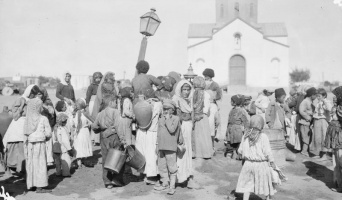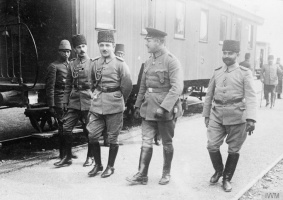Background↑
The Ottoman army had labour battalions during both peace and wartime used for the logistical support of the army. Known as amele taburları in Turkish, these units were attached to the seven armies into which the Ottoman military was organized. In addition to the industrial and artisanal functions they performed at the factories that produced equipment intended for the war effort, labour battalions worked in the fields, increasing the productivity of arable farms. In wartime, labourers were assigned to work on the roads and railways and to transport the supplies the army needed at the battlefront. Because the Ottomans had little railway infrastructure and there was a lack of pack animals, heavy loads were carried daily over vast distances on the backs of the soldiers serving in labour battalions.[1]
Throughout the war, the number of labour battalions varied from seventy to as many as 120.[2] Their total strength ranged from 25,000 to 50,000 men.[3] Most of the conscripts were Christians, amongst whom the Armenians were the largest segment compared to the Greeks and Syriacs. Some Muslims also served in labour battalions. Non-Muslims were barred from serving in the Ottoman army until the conscription laws were changed in 1909 as part of the secular modernization program of the Young Turks.[4] However, shortly after the First World War began, these laws were effectively revoked. Armenians, Greeks, and Jews continued to be conscripted into the Ottoman army, however, their numbers were small and they could not rise beyond the lower ranks. Most were restricted to service behind the frontlines in labour battalions.
Working and Living Conditions↑
The working and living conditions in labour battalions were atrocious, with insufficient food and water supplies, no medical care, and inadequate clothing. The soldiers – underfed, exhausted, many suffering from disease – were subjected to maltreatment by their officers who beat them mercilessly; bastinado and other forms of abuse were commonplace. Regardless of weather conditions, labourers were forced to carry tens of kilograms of weight under escort. Backbreaking work in the mountains and ravines, along with hunger, maltreatment, and exposure to harsh weather conditions killed most of the labourers within a few months.
Conscripts were held in abysmal conditions deliberately, with the express purpose of causing disease and death. Given the degree to which Ottoman army units depended on labour battalions for the construction of roads and railways and for the transportation of arms and materiel for the war effort, the deliberate disregard for the lives of the labourers essentially undermined the Ottoman state’s own war-making capability.
Turning into Concentration Camps↑
In January 1915, the Turks suffered a crushing defeat in the Battle of Sarıkamış. Ottoman Minister of War İsmail Enver (1881-1922) hurried to attribute the loss to Armenian “treachery” rather than to his poor command. On 25 February, the Ottoman General Staff released Enver’s Directive No. 8682 titled “Increased Security Precautions”, which called for the removal of all ethnic Armenian soldiers and officers from command posts and headquarters staffs. Whether Ottoman Armenian soldiers had served loyally and fought bravely on Ottoman fronts, or been conscripted reluctantly and grew indignant at the humiliating demotion was unimportant to Enver and his closest associates.[5]
Starting in late February, Armenian soldiers and other non-Muslims serving in the Ottoman army were removed from active units, disarmed, and transferred into labour battalions. Enver claimed it was a preventive measure against the possibility of the Armenians defecting to the Russians. In reality, the transfer into unarmed units was intended to place the Armenian soldiers in a vulnerable position within the army and deprive the villages they left behind of their potential defenders. With the removal of the Armenian males, the deportations in April proceeded with little resistance.
Death Traps↑
By late March, cases of sporadic murders of Armenian conscripts in labour battalions grew. By the time wholesale deportations began in April, these conscripts were “sitting ducks”, to borrow from Erik-Jan Zürcher,[6] who became the first victims of what would turn into the Armenian Genocide. Kept under guard, they were taken in small batches, sometimes one hundred at a time, to deserted places where they were shot or bayonetted by their Turkish guards or the çetes[7] who roamed the interior.
In one instance in July, some 2,000 conscripts were killed in a labour battalion working near Diyarbekir. Fearful that they would suffer the same fate, those few who were left alive dawdled over their work in order to delay inescapable death. When about a month later Turkish gendarmes came after them, the conscripts struggled on arrest, killing three gendarmes including an officer. The incident was reported to Constantinople, where Mehmed Talaat (1874-1921), minister of the interior and, from 1913 to 1918, de facto head of state, interpreted it as a mutiny in which Armenians had murdered their superiors and Muslims. Soon, thousands of Armenian labourers were killed, mostly with knives and daggers to save ammunition.[8] A German officer who journeyed from Urfa to Diyarbekir saw an entire labour battalion laying by the roadside with their throats slit.[9]
The same measure was adopted against Ottoman Greek soldiers, whose deaths in labour battalions made the deportation columns devoid of resistance. The advent of war saw the internal displacement of Aegean Greek populations and drafting of the Greek males into labour battalions. The geography of the drafts expanded over time to include other Greek populated regions. In Pontus, Greek males were forced into labour battalions and were sent off to remote places in the interior to work in quarries, mines, and on roads, where most died under crippling conditions or were killed by their Turkish guards.
After the War’s End↑
After most Ottoman Armenians were exterminated and many traces of their presence were erased by the Young Turks, Turkish nationalists under Mustafa Kemal (1881-1938) moved on to the Pontic Greeks. When in 1919, the Greeks and the remaining Armenians attempted to create a standalone Greco-Armenian state, Kemal’s nationalist forces thwarted their plan by carrying out population displacements and the destruction of Greek villages in Pontus. In 1920, the National Assembly in Ankara reinstituted conscription to labour battalions for non-Muslims, and the Greeks who continued to serve in the Ottoman army were recruited.
In the same manner as the Young Turks, the Kemalists sought to work Pontic Greek labourers to death in order to eliminate a large number of males who were likely to offer resistance. When Kemalist troops entered Kydonies (Ayvalık), near Smyrna, in 1922, Elias Venezis (1904-1973), a Greek youth of eighteen years, was arrested and conscripted into a labour battalion, remaining “a slave without any rights and even without any official recognition of existence for fourteen months.”[10] Of the 3,000 men in his labour battalion, he was one of only twenty-three to survive.[11]
Tigran Martirosyan, University of Amsterdam
Reviewed by external referees on behalf of the General Editors
Notes
- ↑ These were cargo transportation battalions called hamal taburları in Turkish.
- ↑ The lower bound is obtained from Çatma, Erol: Asker İşçiler [Soldier Workers], Istanbul 1998, pp. 40ff. The upper bound is found in Pomiankowski, Joseph: Der Zusammenbruch des Ottomanischen Reiches. Erinnerungen an die Türkei aus der Zeit des Weltkrieges, Zürich 1928, p. 93.
- ↑ These numbers are arrived at on the basis of witness testimonies in Kévorkian, Raymond: Recueil de témoignages sur l’extermination des amele tabouri ou bataillons de soldats-ouvriers arméniens de l’armée ottoman, in: Revue d’Histoire Arménienne Contemporaine 1 (1995), pp. 289-303.
- ↑ A coalition of nationalist groups, in which the Committee of Union and Progress was the strongest organization, which became the government of the Ottoman Empire during the war.
- ↑ Suny, Ronald Grigor: They Can Live in the Desert but Nowhere Else. A History of the Armenian Genocide, Princeton 2015, p. 244.
- ↑ Zürcher, Erik-Jan: Ottoman Labour Battalions in World War I, in: Kieser, Hans-Lukas / Schaller, Dominik J. (eds.), Der Völkermord an den Armeniern und die Shoah, Zürich 2002, pp. 192-194.
- ↑ Muslim irregular armed squads often made up of brigands.
- ↑ Künzler, Jacob: Dreissig Jahre Dienst am Orient, Basel 1933, p. 54.
- ↑ Germany, Turkey and Armenia: A Selection of Documentary Evidence Relating to the Armenian Atrocities from German and Other Sources, London 1917, pp. 80-85.
- ↑ Vryonis, Speros Jr.: Greek Labour Battalions in Asia Minor, in: Hovannisian, Richard (ed.): The Armenian Genocide. Cultural and Ethical Legacies, New Brunswick 2008, p. 276.
- ↑ Venezis, Elias: From Number 31328. The Book of Slavery (trans. Gabriel Drachman), in Charioteer 2 (1960), p. 110ff.
Selected Bibliography
- Beşikçi, Mehmet: The Ottoman mobilization of manpower in the First World War. Between voluntarism and resistance, Leiden 2012: Brill.
- Cora, Yaşar Tolga: Towards a Social History of the Ottoman War Economy: Manufacturing and Armenian Forced Skilled-Laborers, in: Beşikçi, Mehmet / Somel, Selçuk Akşin / Toumarkine, Alexandre (eds.): Not all quiet on the Ottoman fronts: neglected perspectives on a global war, 1914-1918, Istanbuler Texte und Studien, Würzburg 2020: Ergon, pp. 49-72.
- Kévorkian, Raymond: Recueil de témoignages sur l’extermination des amele tabouri ou bataillons de soldats-ouvriers arméniens de l’armée ottoman, in: Revue d’Histoire Arménienne Contemporaine 1, 1995, pp. 289-303.
- Vryonis, Speros Jr.: Greek labour battalions in Asia Minor, in: Hovanissian, Richard G. (ed.): The Armenian Genocide. Cultural and ethical legacies, New Brunswick 2007: Transaction Publishers, pp. 275-290.
- Yotnakhparian, Levon: Crows of the desert. The memoirs of Levon Yotnakhparian, Tujunga 2012: Parian Photographic Design.









